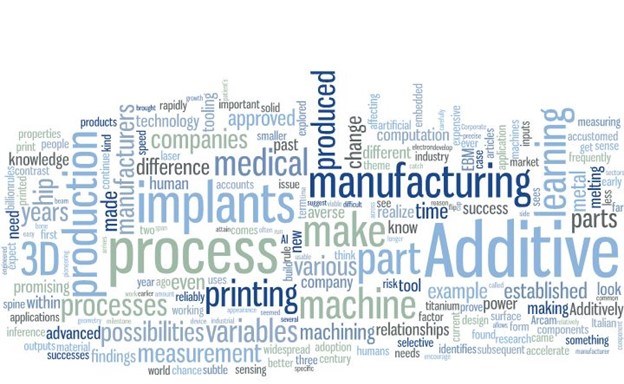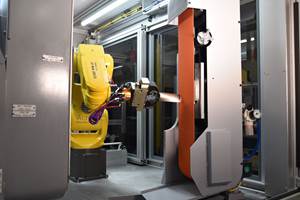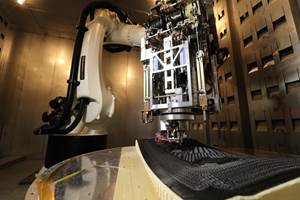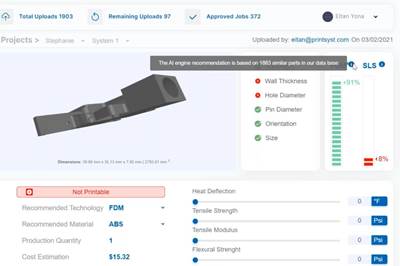Share
Read Next
As a media company and an information content provider, the company I work for is challenged by — and is to some extent struggling against — artificial intelligence.
Meanwhile, artificial intelligence (AI) is also becoming an enabler to the advance of manufacturing, notably by aiding the success of additive manufacturing.
The second item first: The link between AI and AM emerges from the way AI offers one thing and needs something else. It offers a way to find meaningful correlations, and automatically become better and better at applying correlations to control complex systems. What AI needs is data, lots of data — enough data so reliable relationships in the data can be discovered and mapped.
Meanwhile, AM needs the one and offers the other. It needs control over a complex system. Where other manufacturing operations involving a solid mold or cutting solid material are more constrained, AM’s process variables are freer — including being freer to interrelate. But then, AM also offers data, lots of data. Every 3D printed layer potentially offers much to measure at each voxel. AM and AI fit together. As a result, we have seen their relationship advance — and the advance seems to be following a familiar course.
AI has a way of starting out clumsy, then getting less so until it disappears. AI working well is an invisible part of the process. Back in 2018 when we first did an issue of Additive Manufacturing magazine focused on AI, its use was a big deal in part because it was still so apparent. Experimenters were starting to feed it data, embrace the clumsiness and see the benefits. Today, by contrast, AI in AM is settling toward seamlessness, and its benefits are nearer at hand. AI today is helping improve metal deposition; guide decisions about when to use AM; master metal microstructure; control laser powder bed fusion and expand the possibilities of material jetting.

Here is what my writing might look like to artificial intelligence. The word cloud above is a graphical representation of word use (larger size indicates greater use of that word) across nine years of my editorial columns in Additive Manufacturing magazine.
We in media know something of this course. Our product is information rather than objects, so we are a little further along. In the realm of information content, the primary platform in which AI has settled into seamlessness is Google. The AI here is invisible, except when it’s not.
Regions of clumsiness still exist. This website lives within one of them. The site is produced by Gardner Business Media, an information provider concerned with manufacturing and nothing else. That space, manufacturing — like many, many other information spaces — is large enough for a content provider like Gardner to thrive within it, yet too small to offer a sufficient quantity of engagement with all the subsets of information to accurately qualify and categorize the content in this space. Thus, for many different applications and technologies we have covered, we see Google’s AI failing to emphasize the most useful material we have developed on that topic. The disconnect tempts us to make strange accommodations to reshape the content not for the human reader, but for Google’s automation.
Much could be said about this predicament. The insight I want to offer here is simply this: The limitation over the reach of AI for information content likely suggests the way ahead for AI as a tool to guide production. AI will not get invisible all the way. Pockets of clumsiness will exist, and these are the areas where human expertise will be needed.
Within this recent story on the role of AI to engineer metal microstructure, I note the absence of a “handbook” for applying AM. The effective procedures and practices for various outcomes in AM have not been articulated or published. Will they ever be? Can we get to an AM handbook?
I believe the answer is yes and no. On the one hand, AI will be the handbook. As AM becomes faster and cheaper, AI will be able to harness the data generated by the mass production of 3D printed parts to seamlessly get better and better at delivering outcomes the creators of those objects expect. But then there will also be all the narrow, important, high-value uses of AM: the classes of parts in specialized applications where specialists will be needed. That is, where people will be needed — employing some form of handbook (perhaps informal) to guide them in realizing the promise AM delivers to that application. We will have artificial intelligence, yes. But we will also have human intelligence for all the different areas in which AM succeeds, but AI is not able to become invisibly proficient.
Related Content
Aircraft Engine MRO: How Additive Manufacturing Plus Robotic Finishing Will Expand Capacity for Blade Repair
AM offers the chance to bring fast, automated processing to individualized, part-by-part restoration of turbomachinery. A cell developed by Acme Manufacturing and Optomec is able to automatically repair 85,000 unique aircraft engine blades per year.
Read MoreHow 3D Printing Will Change Composites Manufacturing
A Q&A with the editor-in-chief of CompositesWorld explores tooling, continuous fiber, hybrid processes, and the opportunities for smaller and more intricate composite parts.
Read More3D Printed End of Arm Tooling Aids Automation
Frustrations with traditional end of arm tooling led Richard Savage to start 3D printing custom versions for injection molding applications, eventually founding a company to fill this niche.
Read MoreLarge-Format “Cold” 3D Printing With Polypropylene and Polyethylene
Israeli startup Largix has developed a production solution that can 3D print PP and PE without melting them. Its first test? Custom tanks for chemical storage.
Read MoreRead Next
Why Self-Supervised Deep Learning May Be Additive Manufacturing's AI Solution
In collaboration with equipment supplier EOS, artificial intelligence experts at NNAISENSE have created a self-taught “deep digital twin” to advance additive manufacturing, starting with direct metal laser sintering of titanium.
Read MoreGenetic Engineering for Metal: The Promise of Microstructure Control via Additive Manufacturing
“To design the alloy, design the microstructure,” says this Ohio materials science startup. Artificial intelligence is helping to realize a design tool for determining the properties of 3D printed metals.
Read MorePrintSyst Automates AM Decision Making with AI (Includes Video)
The startup’s cloud-based artificial intelligence tool is designed to help companies adopting additive manufacturing make fast, easy decisions about what and how to 3D print.
Read More












.png;maxWidth=300;quality=90)











